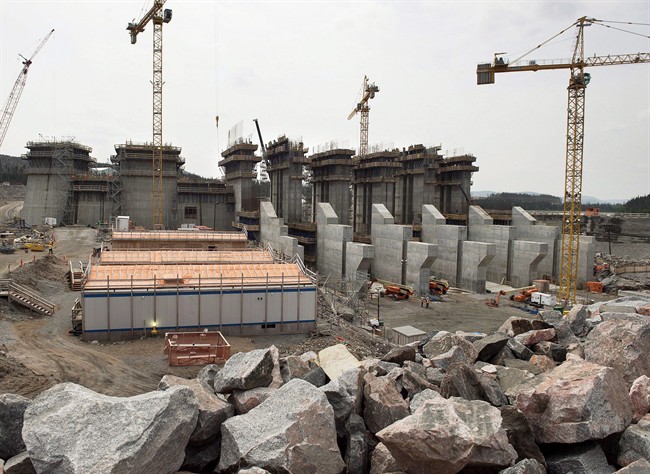An historic milestone was recognized Wednesday on the East Coast, but the mood was bittersweet.

A power link connecting the Muskrat Falls hydro megaproject to Newfoundland and Labrador’s capital was formally “energized” for the first time.
The Soldiers Pond transmission site, located 40 minutes outside of St. John’s, is connected to Labrador by a 1,100-km power line.
READ: Muskrat Falls hydro project price tag rises by another billion: CEO
The moment signifies the completion of the drawn-out Muskrat Falls project is near. The Labrador hydro generation facility is 90 per cent done.
The energy will come at a great cost, however – a public inquiry has been appointed to study how Muskrat Falls’ estimated $6.2 billion price tag has more than doubled to $12.7 billion.
And it will bring much higher power costs in the province. Electricity rates are expected to double by 2022, a burden Premier Dwight Ball has said he is working to mitigate.
Stan Marshall, CEO of Muskrat Falls owner Nalcor Energy, said the hikes are a side effect of the province’s investment in a project that is too large for the relatively small population. He has called Muskrat Falls a colossal “boondoggle” that he’d try to fix.
“It’s a faulty concept in the sense that we built something that didn’t match our needs,” said Marshall, who took over as head of the Crown corporation in 2016 after the governing Liberals criticized oversight.

Get daily National news
“If you need a new car to go to work for the next 10 years, and you go buy yourself a Lamborghini, at the end of the 10 years, you got a 10-year-old Lamborghini. You may not have eaten or slept for 10 years. But you paid for it.”
Stephen Crocker, a sociology professor at Memorial University, describes the cost to the province’s electricity consumers with a less glamorous metaphor.
“A simple way of thinking about it is that we have been forced to buy a baseboard heater that is four times bigger than we need. And 1/8we 3/8 have to pay for that every time we turn up the heater,” said Crocker.
WATCH: Protesters explain why they’re bringing the issue of the Muskrat Falls dam to Ottawa

Crocker doesn’t see the symbolic flipping of the switch as a cause for celebration. He sees the moment as the “beginning of the end” of the construction phase and the start of a “a cruddier, more unpleasant future” for the province’s residents.
Marshall said Wednesday’s showcase of the now-completed transmission site doubled as a formal recognition of the Labrador-Island link’s energization and the workers who got it up and running.
Marshall said that while he and many others have criticized the concept and scale of a project that will produce more power than the province needs, or is able to sell, he’s appreciative of the workers’ efforts in completing the elaborately engineered transmission link.
“If the battle fails, don’t blame the soldiers. Blame the generals,” said Marshall.
Nalcor representatives told reporters that Soldiers Pond has actually been channeling Labrador power to the island of Newfoundland’s residents in limited amounts since the end of May.
The transmission site will supply full power to the island’s residents by 2020.
Crocker says one major, often overlooked concern is that low income residents will feel the harshest effects of increasing power bills.
“For people on lower, little, or no income, it really means less heat,” said Crocker.
Crocker said even if the worst case scenario – that the province is unable to pay for the project – doesn’t come true, Newfoundlanders and Labradorians can look forward to chillier winters once Muskrat Falls power comes online.
“A colder future, a hungrier future, and more dangerous future for the people in Labrador. All of that is what it represents to me,” said Crocker.
As well, residents of the Labrador Inuit communities directly downstream from the construction site have held protests over the last few years, expressing concern that their water supply will be poisoned with dangerous levels of methylmercury.







Comments